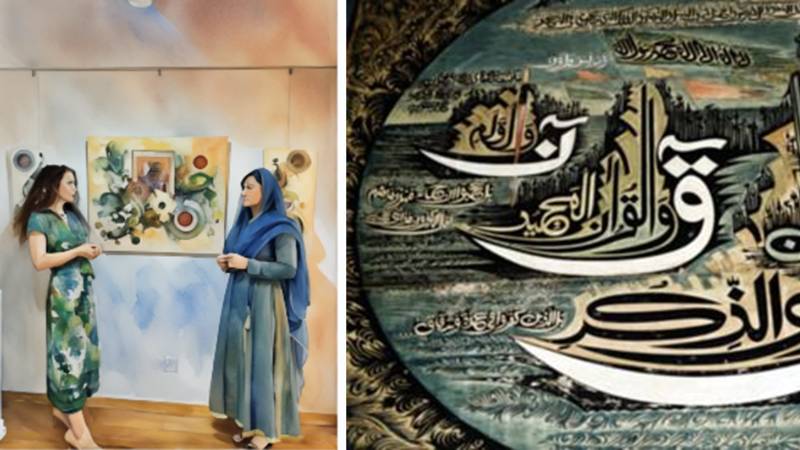
In Pakistan, calligraphy has long been celebrated as a sacred art form, intertwined with the country’s cultural and religious roots. Traditionally, calligraphy adorned the walls of mosques, religious texts, and historical monuments, with its fluid lines and profound meaning serving as a bridge between faith and artistry. However, in recent years, this centuries-old art has experienced a remarkable resurgence, evolving to find a place in contemporary art galleries, home interiors, and digital media. This revival is not only preserving a vital part of Pakistan’s heritage but is also reshaping it to resonate with modern audiences.
Islamic calligraphy, with its intricate curves and elaborate strokes, has held a place of deep respect across the Muslim world for centuries. In Pakistan, this reverence is visible in historical landmarks such as Lahore’s Badshahi Mosque and Islamabad’s Faisal Mosque, where calligraphy enhances the spiritual aura with inscriptions of Quranic verses. In these spaces, calligraphy has traditionally represented devotion, its practice revered as both an art form and a sacred act.
Historically, Pakistani calligraphers adhered strictly to Arabic script, with each stroke crafted to honour the words it carried. But in recent years, the art has transformed, no longer confined to purely religious purposes. Today, young Pakistani calligraphers are blending the traditional with the contemporary, exploring both Urdu and English scripts, and pushing the boundaries of this ancient craft.
A New Generation of Calligraphers: From Tradition to Trend
The calligraphy renaissance in Pakistan is led by a new wave of artists who are reimagining the art form with innovative materials, styles, and themes. One of the early pioneers of this modern movement was the renowned Sadequain, whose experimental approach to calligraphy in the 1960s inspired future generations to view calligraphy as a medium for self-expression, not just religious devotion. Today’s artists, following in his footsteps, are merging Islamic art with abstract and surreal aesthetics, creating pieces that captivate diverse audiences in Pakistan and beyond.
Among the notable contemporary artists is Haji Noor Deen, a Pakistani calligrapher known internationally for blending Chinese and Arabic calligraphy styles. In Pakistan, institutions such as the National Art Gallery in Islamabad and the VM Art Gallery in Karachi now frequently host calligraphy exhibitions, where visitors can experience the art form in new, dynamic ways. This artistic freedom has empowered Pakistani calligraphers to explore a wide array of themes, from love and identity to social justice, enriching the narrative of calligraphy in Pakistan.
Modern Galleries and Public Spaces
With calligraphy’s shift from religious settings to modern spaces, the way people interact with the art has evolved. In contemporary galleries, calligraphy is not just decoration but a form of self-expression, open to diverse interpretations. Artists now experiment with colours, textures, and mediums that distinguish their work from traditional monochromatic pieces, making calligraphy more accessible and visually engaging.
Some artists are using acrylics, spray paint, and mixed media to bring calligraphy to life on large canvases, while others create intricate digital designs that can be printed on various surfaces, popular as home decor. In urban areas, vibrant calligraphy murals beautify city walls, contributing to a cultural revival while connecting citizens to their heritage. This trend is visible in cities such as Karachi and Lahore, where public art initiatives have encouraged the display of calligraphy on buildings and street corners, transforming urban spaces with a touch of tradition.
Today, young Pakistani calligraphers are blending the traditional with the contemporary, exploring both Urdu and English scripts, and pushing the boundaries of this ancient craft
Social media platforms like Instagram and Pinterest have amplified the resurgence of calligraphy, providing Pakistani artists with a global platform to share, sell, and even commission custom pieces. Today, calligraphy is a popular choice for home decor, with people using it to personalize living spaces, offices, and even wedding decor. Artists frequently share time-lapse videos of their creative process, which not only makes calligraphy more accessible to wider audiences but also inspires younger generations to appreciate and explore the art form.
Through digital platforms, calligraphers reach audiences unfamiliar with the art’s deep cultural roots, sparking interest across generations. The widespread sharing of calligraphy also showcases the ways in which ancient art can be reinterpreted, inspiring many young artists to take up the craft.
Despite its revival, calligraphy in Pakistan faces significant challenges. Mastery in traditional calligraphy requires years of disciplined training under skilled mentors, and only a few institutions in the country offer formal instruction in the craft. Some segments of the public also view calligraphy as a sacred form, which can lead to hesitance or resistance toward modern interpretations. Additionally, high-quality art materials remain costly, making it difficult for emerging artists to sustain their practice independently.
Nonetheless, the future of calligraphy in Pakistan appears promising. With access to online tutorials, artist communities, and more affordable materials, an increasing number of young Pakistanis are embracing calligraphy as a viable career. Organizations like the Pakistan National Council of the Arts (PNCA) have begun promoting the art through workshops and exhibitions, recognizing calligraphy as an integral part of the country’s cultural legacy.
The revival of calligraphy in Pakistan is more than a trend—it represents a bridge between past and present, highlighting how tradition can be reimagined within modern contexts. Through calligraphy, Pakistani artists are expressing their beliefs, emotions, and identities, making the art relatable and accessible to today’s audiences. This resurgence is preserving an important part of Pakistan’s heritage, showcasing the resilience and adaptability of the country’s creative spirit.
From gallery exhibitions and urban murals to digital platforms, the calligraphy comeback reflects Pakistan’s evolving artistic landscape and the enduring power of cultural heritage. In an era where change is constant, this revival of calligraphy serves as a reminder of art’s timeless relevance and its unique ability to adapt while honouring its roots.

